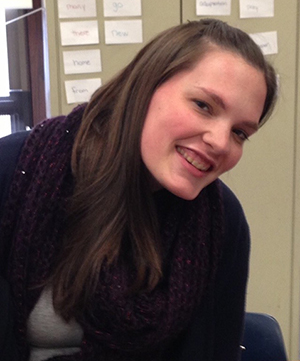
Megan Maybray
One night last week, Megan Maybray was panicking.
A Holocaust survivor named Rita Ross was visiting her school, Kennett Middle School near Philadelphia, the next day, but Maybray was having trouble teaching her ESL students about the Holocaust. Her students are new arrivals to the United States and most know little English. Maybray had never really taught the Holocaust before and could tell that her previous attempt to introduce them to the basics had not had much of an impact.
“I wasn’t sure they were getting the extent of how serious it was,” Maybray said. “Pictures can only do so much.”
Luckily, one of Maybray’s friends from college is Kia Hays, project specialist in the research and documentation department of USC Shoah Foundation. Maybray asked Hays if she knew of any Holocaust resources she could use in her classroom the next day, and Hays pointed her to the Spanish-language portal on the USC Shoah Foundation website. There, Maybray found clips of Spanish-language testimonies of Holocaust survivors who immigrated to Argentina after the war.
Maybray showed about 15 minutes of the testimonies to her class, and the room was silent – which, for a middle school classroom, is saying something, she joked. They were surprised to learn that people who spoke Spanish had been involved in the Holocaust, and the testimonies allowed them to really understand what the survivors had been through.
“They were amazed that someone who spoke their language had lived through that,” Maybray said.
Students asked lots of questions about why the Nazis persecuted the Jews, how they got out of the concentration camps, whether survivors found their families after, and why some of them immigrated to Argentina. Maybray led the class in a discussion about why countries in South America welcomed survivors and they did additional research about the camps that were mentioned in the clips.
She said the online testimonies were very convenient for her to use in the classroom. Being able to show her students materials in their own language made all the difference in getting them interested and engaged in learning about the Holocaust, and to really understand what it was about. It also gave them a gateway to appreciating Holocaust survivor Rita Ross’s visit and understanding her experiences.
“I explained to the students that Rita Ross was a survivor like the people we had just seen in the videos,” Maybray said. “So while they may not understand what she was saying, she lived through the same things as the persons in the video.”
The Spanish-language testimonies were the “saving grace” of her lesson, Maybray said.
“It brings it to a more personal level,” Maybray said, “I can translate from English to Spanish, but for someone to speak firsthand, not translated, it hit them more and became more real for them.”